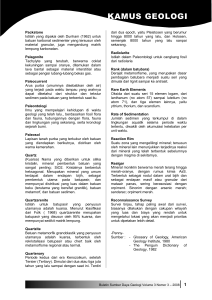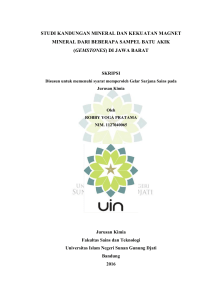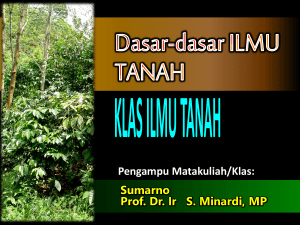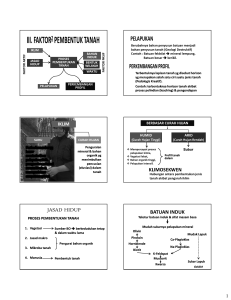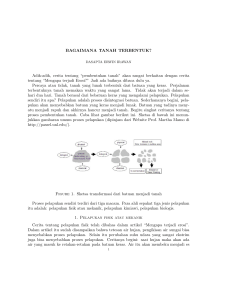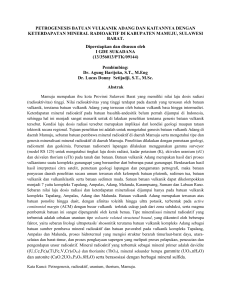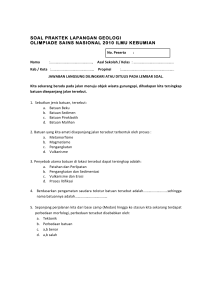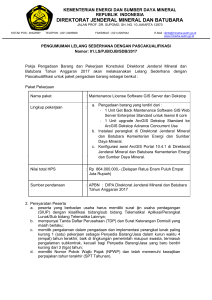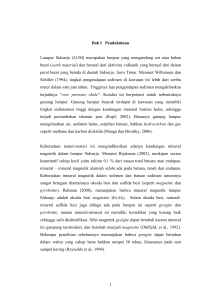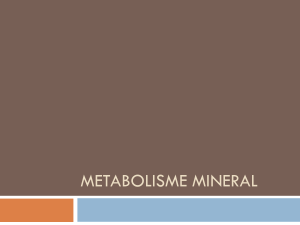proses pelapukan batuan dan mineral
advertisement
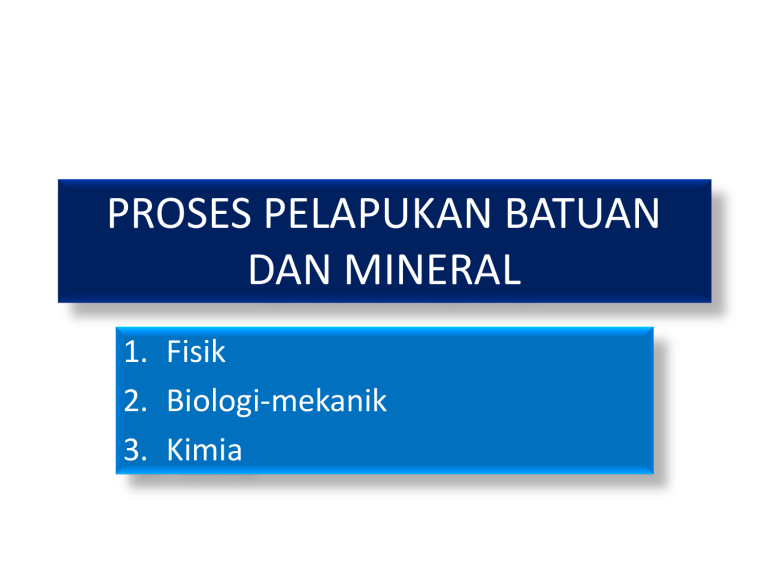
PROSES PELAPUKAN BATUAN DAN MINERAL 1. Fisik 2. Biologi-mekanik 3. Kimia ASAL TANAH 1. Batuan keras : beku, sedimen, metamorfosis 2. Bahan lebih lunak dan lepas (abu volkan, bahan endapan baru) PELAPUKAN refers to numerous processes that convert bedrock exposed at earth's surface to smaller pieces that can be eroded by wind, rivers, waves or glaciers, as well as processes that chemically attack minerals in rock to produce a variety of dissolved substances. is that suite of processes acting at or near the Earth's surface that either reduce the particle size, alter the mineral combination, or both of rocks. Weathering • The breaking down of rocks and other materials near or on the Earth’s surface is called weathering. A slow, continuous process, it affects all substances exposed to the atmosphere. BATUAN KERAS REGOLIT Bahan-bahan lepas (termasuk tanah) yang berada di atas batuan TANAH PELAPUKAN FISIK • Tahap awal proses pelapukan • Dua tahap : 1. Pemecahan jadi bagian dg ukuran bervariasi 2. Pelembutan jadi bagian dg ukuran lebih kecil + agak merata • Ciri : 1. tdk ada perubahan susunan kimia 2. tdk ada pembentukan mineral baru Terjadi cepat pd daerah dg perbedaan suhu tinggi Di sub tropis / daerah dingin tanah tua Tropis tanah muda PELAPUKAN FISIK Mechanical weathering by exfoliation (sheeting) (left) Exfoliation occurs as rocks expand when brought to the surface from deep in the crust where pressures are much higher than at the surface. Photo: exfoliating granite in Yosemite National Park Mechanical weathering by frost action (right) Freezing and thawing widens fractures over time. Pieces can then fall off the cliff and move down the slope Temperature Rocks can be broken apart by changes in temperature. As rocks are heat up in the sun during the day, the outside of the rock expands. The inside of the rocks remain cool and do not expand. When the air temperature drops at night, the outside of the rock cools and contracts. This continuing cycle causes particles to break off. This is called exfoliation. Frost Action Unlike most liquids, water expands when it freezes. The repeated freezing and melting of water, called frost action, is another cause of mechanical weathering. When water freezes in cracks in the rocks, it expands, making the crack larger.In time, this causes the rock to break into pieces. PELAPUKAN KIMIA • Pelunakan + penguraian pecahan batuan dan mineral ke dalam elemen penyusunnya yang sering diikuti dengan pembentukan mineral baru (mineral sekunder). • Suhu + air berpengaruh besar • Tropis (t + ch besar) pelapukan kimia cepat • Hasil : mineral liat • • • • • Hidrasi CaSO4 + 2H20 CaS04 2H20 Mineral lebih lunak Dehidrasi CaS04 2H20 CaS04 + 2H20 • • • • OKSIDASI Fe++ Fe+++ + edisintegrasi mineral mudah hancur • REDUKSI • Fe+++ + e- Fe++ • Mobil mudah tercuci • HIDROLISIS • K Al Si3 08 + H+ H Al Si3 O8 + K+ • Feldspar • Struktur kristal rusak + mudah hancur PELAPUKAN BIOLOGIK -MEKANIK Pemecahan/penguraian batuan akibat kegiatan hewan atau tanaman : • Akar pada retakan batu • Rayap, semut, serangga merombak BO + mencampurkan dengan mineraltanah. • Penguraian BO as.organik + CO2 The roots of plants sometimes loosens rock material. A plant growing in a crack can make the crack larger as the root spread out. This is known as root-pry. It is organic since this activity is caused by living things. PROSES PELAPUKAN BATUAN 1.Disintegrasi : – Gejala mekanika – Proses pengurangan ukuran batuan dan mineral tanpa mempengaruhi komposisi mineral 2. Dekomposisi : – Gejalan kimia – Terjadi perubahan kimia • Proses pelapukan batuan : proses geologi • proses pembentukan tanah : proses pedologi Rate of Weathering The rate of weathering depends on several factors, including: 1. The composition of the rock 2. The amount of time that the rock is exposed on the Earth’s surface 3. The amount of exposed surface on a rock Composition of Rocks • Two different types of rocks in the same climate can weather differently, depending on the minerals that make up each rock type. If the minerals in a rock resist chemical weathering, the rock is called a stable rock. The stability of a rock can vary depending on the climate in which the rock is found. Limestone is stable in a dry climate but not in a wet climate. Amount of Time of Exposure • The amount of time that rock is exposed on the Earth’s surface also affects its rate of weathering. A very old rock that has not been exposed to the forces of weathering can remain almost unchanged. If a newly formed rock is deposited on the Earth’s surface it will begin to weather right away. The Amount of Exposed Surface • The amount of exposed surface area on a rock also affects its rate of weathering. As rocks are broken down into many small pieces, more rock surfaces are exposed and more weathering takes place. In rocks that contain many joints or cracks, various chemicals easily come into contact with the rock surfaces and break them down. TANAH SEBAGAI SISTEM TERBUKA INPUT : •Pelapukan batuan •Pelapukan BO •presipitasi OUT PUT : Serapan hara oleh akar evapotranspirasi pencucian SUSUNAN KIMIA DAN MINERALOGI BAHAN INDUK MINERAL 1. SILIKAT 2. BUKAN SILIKAT SILIKAT • Struktur sangat kompleks • Satuan utama Silika-oksigintetrahedron : • Ion silika sebagai pusat dikelilingi 4 ion-ion oksigen yang berdekatan dengan jarak sama • Pembagian : – – – – Rangka silikat : pyroksin, amphibil Rantai silikat : olivin, zirkon Orto dan lingkaran silikat : Lempeng silikat : mika BUKAN SILIKAT • Struktur sederhana • Variasi dalam kelarutan + ketahanan terhadap penguraian • Oksida-oksida, hidroksida-hidroksida, sulfatsulfat, klorida-klorida, karbonat-karbonat, fosfat-fosfat • Keberadaan mineral kuarsa yang tinggi dalam tanah dapat mengindikasikan tiga hal: (1) tanah sudah mengalami tingkat perkembangan lanjut; (2) cadangan sumber hara tanah yang rendah; (3) bahan induk tanah tersebut bersifat masam.

